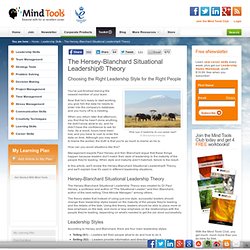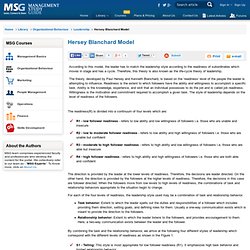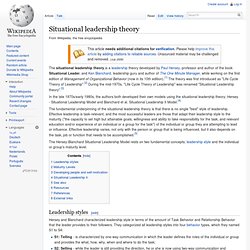

Situational Leadership. Disciplines > Leadership > Leadership styles > Situational Leadership Assumptions | Style | Discussion | See also Assumptions The best action of the leader depends on a range of situational factors.

Style When a decision is needed, an effective leader does not just fall into a single preferred style, such as using transactional or transformational methods. Factors that affect situational decisions include motivation and capability of followers. The leaders' perception of the follower and the situation will affect what they do rather than the truth of the situation. Yukl (1989) seeks to combine other approaches and identifies six variables: Subordinate effort: the motivation and actual effort expended. Leaders here work on such factors as external relationships, acquisition of resources, managing demands on the group and managing the structures and culture of the group.
Discussion See also Hersey and Blanchard's approach, Vroom and Yetton's Normative Model Maier, N.R.F. (1963). Yukl, G. The Hersey-Blanchard Situational Leadership Theory - Leadership Skills from MindTools. Choosing the Right Leadership Style for the Right People What type of leadership do your people need?

© iStockphoto/oversnap You've just finished training the newest member of your team. Now that he's ready to start working, you give him the data he needs to enter into the company's database, and you hurry off to a meeting. When you return later that afternoon, you find that he hasn't done anything. How can you avoid situations like this? Management experts Paul Hersey and Ken Blanchard argue that these things happen because leaders don't match their style of leadership to the maturity of the people they're leading. In this article, we'll review the Hersey-Blanchard Situational Leadership® Theory, and we'll explain how it's used in different leadership situations.
Hersey-Blanchard Situational Leadership Theory Leadership Styles According to Hersey and Blanchard, there are four main leadership styles: Telling (S1) – Leaders tell their people what to do and how to do it. Maturity Levels Key Points. Hersey Blanchard Model. The readiness(R) is divided into a continuum of four levels which are: The direction is provided by the leader at the lower levels of readiness.

Therefore, the decisions are leader directed. On the other hand, the direction is provided by the followers at the higher levels of readiness. Therefore, the decisions in this case are follower directed. When the followers move from low levels to high levels of readiness, the combinations of task and relationship behaviors appropriate to the situation begin to change. For each of the four levels of readiness, the leadership style used may be a combination of task and relationship behavior. Task behavior: Extent to which the leader spells out the duties and responsibilities of a follower which includes providing them direction, setting goals, and defining roles for them. Custom Search. Situational leadership theory. The situational leadership theory,is a leadership theory developed by Paul Hersey, professor and author of the book Situational Leader, and Ken Blanchard, leadership guru and author of The One Minute Manager, while working on the first edition of Management of Organizational Behavior (now in its 10th edition).[1] The theory was first introduced as "Life Cycle Theory of Leadership".[2] During the mid-1970s, "Life Cycle Theory of Leadership" was renamed "Situational Leadership theory".[3] In the late 1970s/early 1980s, the authors both developed their own models using the situational leadership theory; Hersey - Situational Leadership Model and Blanchard et al.

Situational Leadership II Model.[4] The fundamental underpinning of the situational leadership theory is that there is no single "best" style of leadership. The Hersey-Blanchard Situational Leadership Model rests on two fundamental concepts; leadership style and the individual or group's maturity level. Leadership styles[edit]